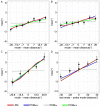Ensemble averaging: What can we learn from skewed feature distributions?
- PMID: 36602815
- PMCID: PMC9832727
- DOI: 10.1167/jov.23.1.5
Ensemble averaging: What can we learn from skewed feature distributions?
Abstract
Many studies have shown that observers can accurately estimate the average feature of a group of objects. However, the way the visual system relies on the information from each individual item is still under debate. Some models suggest some or all items sampled and averaged arithmetically. Another strategy implies "robust averaging," when middle elements gain greater weight than outliers. One version of a robust averaging model was recently suggested by Teng et al. (2021), who studied motion direction averaging in skewed feature distributions and found systematic biases toward their modes. They interpreted these biases as evidence for robust averaging and suggested a probabilistic weighting model based on minimization of the virtual loss function. In four experiments, we replicated systematic skew-related biases in another feature domain, namely, orientation averaging. Importantly, we show that the magnitude of the bias is not determined by the locations of the mean or mode alone, but is substantially defined by the shape of the whole feature distribution. We test a model that accounts for such distribution-dependent biases and robust averaging in a biologically plausible way. The model is based on well-established mechanisms of spatial pooling and population encoding of local features by neurons with large receptive fields. Both the loss functions model and the population coding model with a winner-take-all decoding rule accurately predicted the observed patterns, suggesting that the pooled population response model can be considered a neural implementation of the computational algorithms of information sampling and robust averaging in ensemble perception.
Figures







References
-
- Ariely, D. (2001). Seeing sets: Representation by statistical Properties. Psychological Science, 12(2), 157–162. JSTOR. - PubMed
Publication types
MeSH terms
LinkOut - more resources
Full Text Sources

